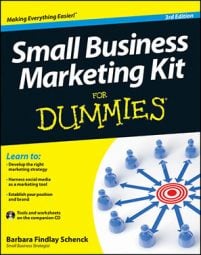Good blogging follows a blogger-designed posting schedule and an established blog-post format. Although you might be tempted to create a rigorous blog-post schedule, blog only when you have quality content to deliver. Planning your blog-post approach helps you attract the audience you desire, and to keep it.
Establish a small business blogging calendar
To plan your blog posts, take these steps:
Divide your blog into categories that address various aspects of the topic you plan to blog about.
By establishing categories, you improve your blog in two ways: You can save posts by categories, which makes them easily findable by those searching your blog archive, and your categories become a planning tool as you plan monthly posts.
For example, John Jantsch uses the following categories on his widely cited Small Business Marketing Blog: Duct Tape Marketing, DTM Favs, Marketing Plans, Marketing Strategy, Referral Marketing, Social Media, and Web Marketing.
Plan your posts on a monthly basis.
Every month, use your blog categories to guide your editorial decisions. Look through your category list and decide on blog posts that allow you to address a wide range of category titles. Need ideas? Look for questions you’re asked repeatedly by clients and others, address them in a blog post, and then share the link the next time the question arises.
You don’t have to post everything all by yourself or even with your staff. Consider placing a standing invitation for guest posts on your blog, along with your topic and word-count requirements and your interest in blog exchanges.
Reach out directly to bloggers or business associates for guest posts. Or find other blogs on your topic and feature information from a few posts, along with links back to the authors.
Perfect your small business blog post
Every blog post needs to do two things: convey information of interest to the target audience and inspire the target audience to take a desired action, whether by clicking to reach your website or by clicking to share the post — or both. Here’s what you need to include in your posts in order to achieve these goals:
A blog post title or headline: This title needs to grab attention and interest, not unlike an ad headline. Include keywords that describe the post so it will be found by people when they’re seeking similar information in web searches.
Subheadings: These should feature keywords and give those who skim and skip around your post a good idea of what the text contains.
A post description: If your blog platform allows you to enter a meta-description, do so, writing a keyword-rich summary of your post that appears as a snippet in search results. Otherwise, search engines simply grab the first 160 characters they see on your page, so be sure that the introduction to your post summarizes the post, incorporates keywords, and stands well on its own in search results.
Accurate information: Present your information in good old-fashioned journalistic fashion, with the most important info first and supporting info in the following paragraphs.
In-text links: These lead blog readers to landing pages where they can access the information or take the action mentioned in the post. Limit links to one for every 100 words of text. More than that looks a little spammy.
Calls for engagement: These come in the form of newsletter signups, RSS subscriptions, social sharing buttons, comment requests, invitations to participate in polls or answer questions, or any other simple request that prompts the interaction you seek.
Credit where credit is due: If you’ve quoted someone or included shared content, cite your source, along with your thanks.
A blog post author byline: Whether written by you or someone else, end the post with the author’s name, title, and contact information.
When you’re done, proofread and proofread again. And finally, double-check that search engines are likely to find your post, which means using plenty of text, references to experts, outbound hyperlinks to respected sites, and your physical location.
Measure the ROI of your small business blog
Blogging can be fun and personally gratifying, but it only works for your business if it delivers a return on investment (ROI) by developing leads, prospective customers, and, ultimately, customer relationships.
To make blogging effective, start with a clear idea of what each post is to accomplish. After reading the post, what do you want people to do?
If you want them to click to a landing page on your site, you can measure page traffic. If you want them to fill out a form and download an e-book or white paper, you can measure registrations and downloads. If you want them to share, easy enough — you can measure social media shares.
Know what you want blog post readers to do. Present a clear call to action. Then measure success by counting site visitors, completed lead forms, inbound links, e-newsletter or blog subscribers, social media shares, or any other next step you invited readers to take.

